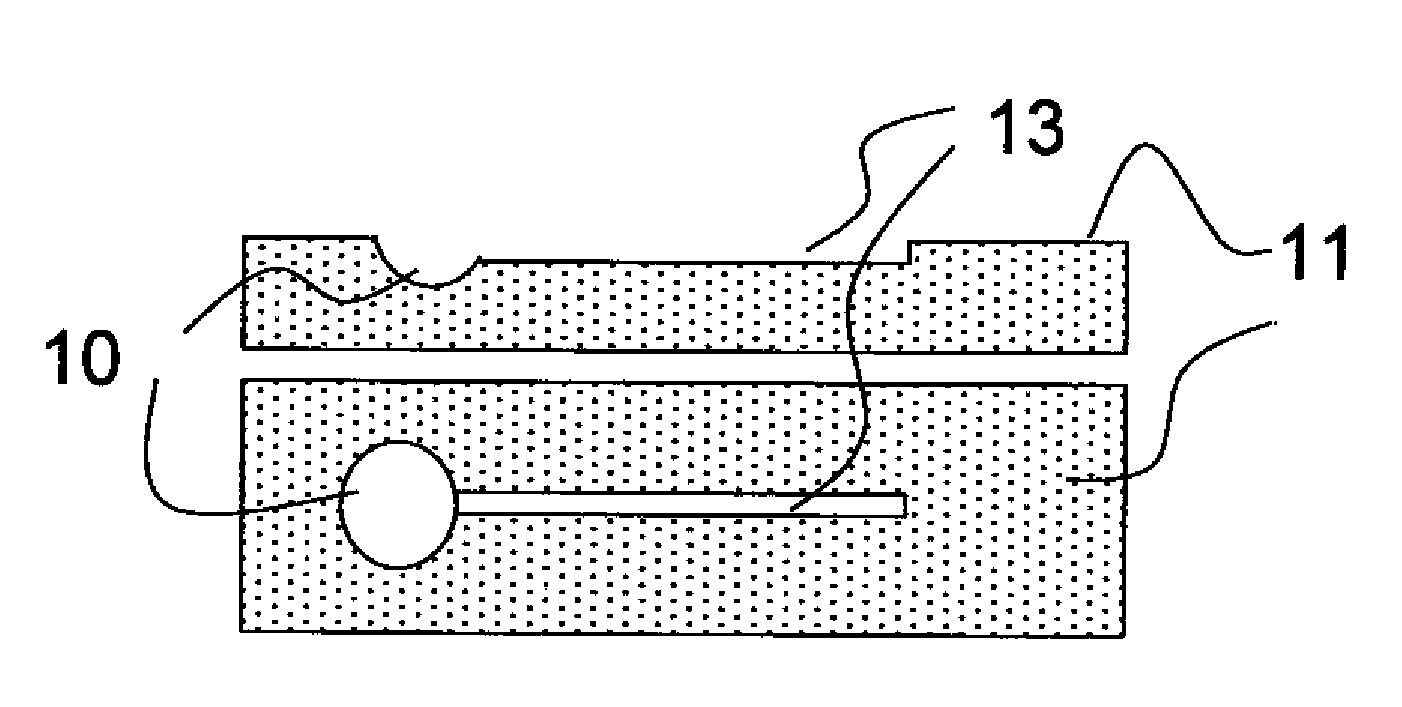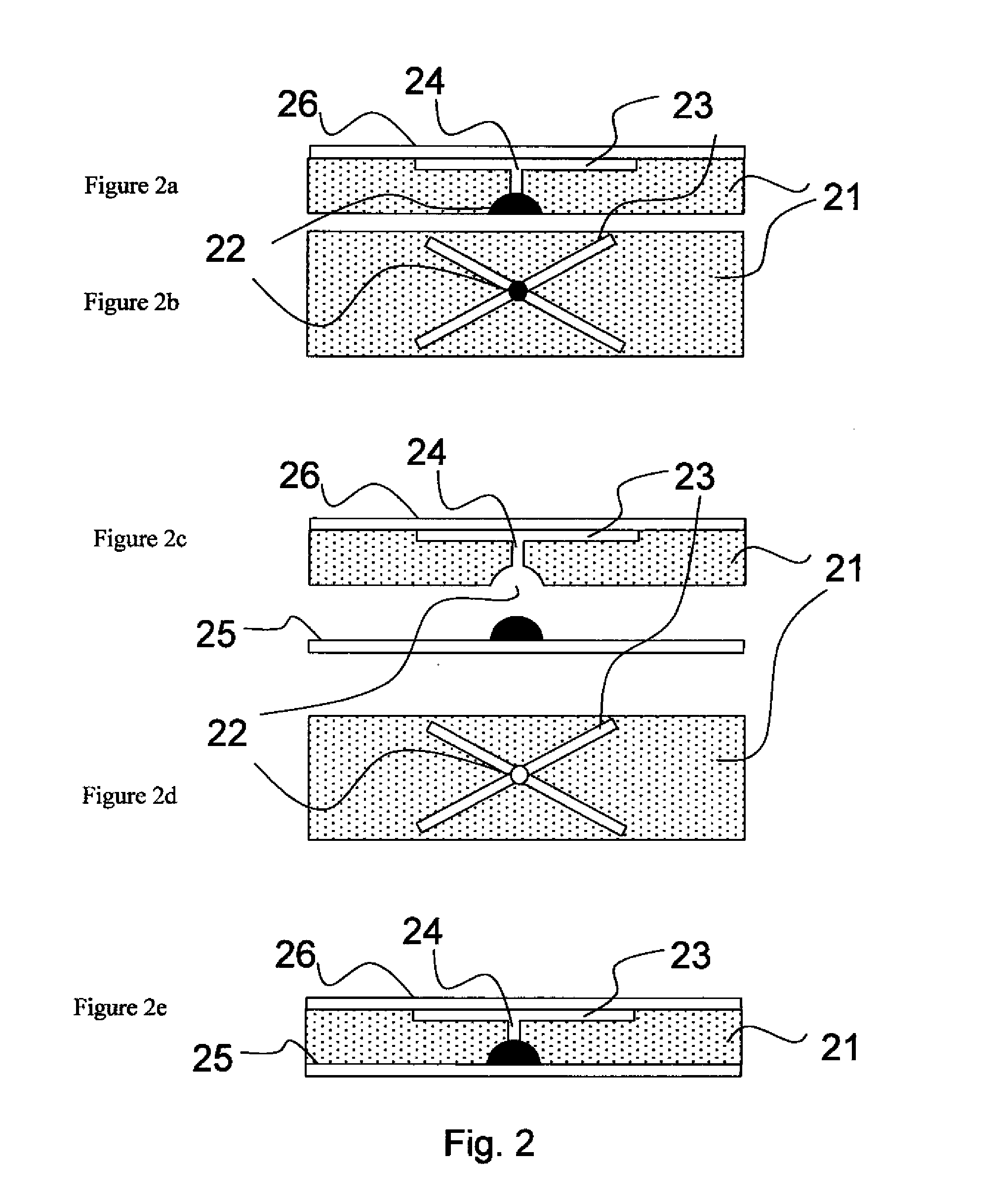Indicators
a technology of indicator device and indicator body, which is applied in the direction of thermometer using mean/integrated value, instruments, heat measurement, etc., can solve the problems of constant reduction of electronic components, prohibitive device and integration cost, etc., and achieves low cost, simple design, and easy manufacturing
- Summary
- Abstract
- Description
- Claims
- Application Information
AI Technical Summary
Benefits of technology
Problems solved by technology
Method used
Image
Examples
example 1
[0043]Embossed channels were created in 100 μm thick PET film, using a circular cutting tool pressed into the substrate. This resulted in a circular channel with a diameter of approximately 10 mm and a ‘V’ shaped cross section with a width of approximately 50 μm. A small section of the channels was filled with eicosane having a low concentration (1-10% w / w) of Sudan Red dye, by pushing a few micrograms of the material into the channels with gentle pressure, the eicosane had a melting point of approximately 38° C., making it possible to locally melt the eicosane to allow channel filling, but prevent flow along the channel. When the substrate was warmed to this temperature the eicosane became mobile and was driven along the channel by capillary forces, thereby creating a circular pattern indicating that the device had been activated by having passed through a temperature threshold of 38° C.
example 2
[0044]Channels were created on a PET substrate or a PE coated paper substrate using photolithography. Both Laminar and SU-8 50 photo-resist were used to create approximately 50 μm thick channels on the substrate. Alkanes with different melting points around 50° C. were used as the flowable indicator. Some oil soluble dye was added to improve visibility. Oil Red, Sudan Red and Oil Blue dyes were found to work well with octadecane, nonadecane and eicosane, by simply adding a small quantity (1-10% w / w) of solid Sudan Red dye to a molten solution of the alkane. SU-8 50 was used in preference to the Laminar resist since it is near transparent, making the unfilled channels difficult to detect on the PET substrate. The resist was spin coated for 30 seconds at 500 rpm followed by 40 seconds at 2000 rpm to result in an approximately 50 μm thick layer. Soft-bake times of approximately 5 minutes at 65° C. and approximately 20 minutes at 95° C. were required to cure properly before exposure. Ex...
example 3
[0045]A sample of 500 μm pitch ‘V’ channels (3M SOLF film) was overcoated with a thin layer of titania 10 to 50 nanometres thick by chemical vapour deposition at 100° C. The titania was then rendered hydrophobic by spin coating 0.3% w / w Fluoroalkyl silane (FAS) in decane, to deposit a thin layer of the FAS on the titania. This increased the sensitivity to UV light since it has been shown that exposure of this layer to UV light causes catalytic destruction of the FAS layer rendering the titania surface hydrophilic. A liquid ink placed on this sample will not wick along the channels until they have been exposed to UV light to make them hydrophilic. In this example a small quantity of aqueous black ink with constituents;
[0046]Water+
[0047]Diethylene glycol—14-22%
[0048]Black colourant 13-14%
[0049]Butoxy tri glycol 10%
[0050]Urea 3-6%
[0051]Triethanolamine 1-3%
was placed into the channels and observed over time. Due to the FAS, the liquid has a large contact angle on the surface of the chan...
PUM
| Property | Measurement | Unit |
|---|---|---|
| contact angle | aaaaa | aaaaa |
| resonance frequency | aaaaa | aaaaa |
| thick | aaaaa | aaaaa |
Abstract
Description
Claims
Application Information
 Login to View More
Login to View More - R&D
- Intellectual Property
- Life Sciences
- Materials
- Tech Scout
- Unparalleled Data Quality
- Higher Quality Content
- 60% Fewer Hallucinations
Browse by: Latest US Patents, China's latest patents, Technical Efficacy Thesaurus, Application Domain, Technology Topic, Popular Technical Reports.
© 2025 PatSnap. All rights reserved.Legal|Privacy policy|Modern Slavery Act Transparency Statement|Sitemap|About US| Contact US: help@patsnap.com



